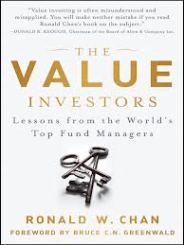The value investors: Lessons from the world’s top fund manager (Part 1)
Author: Ronald W. Chan
Walter Schloss (Walter & Edwin Schloss Associates)
“I learned that if I can simply survive in the market, just like surviving in the war, and not lose money, eventually I will make something”
“The best way to invest is to lay out rules which, if followed, would reduce the chance of loss”
“Nothing terrible happening to you is a profit”
“Understand ones strengths and weakness… When you have made a sound decision, make sure you have the courage to stick to it”
Strategy:
– Finding net-nets
(CA – Liabilities) / total share outstanding
– Stocks selling below their book value
– Buy assets instead of earning since assets don’t change quickly unlike earnings
– Diversify (50 – 100 stocks)
– Doesn’t worry about macro factors, or the underlying business, but whether the stock is undervalued
– Average holding period was about four to five years
Irving Kahn (Kahn Brothers Group)
“There is always something to do. You just need to look harder, be creative and a little flexible”
“The depression taught me what frugality means and the importance of not losing money”
“If you complain that you cannot find opportunities means you either have not look hard enough or you have not read broadly enough”
Strategy:
– Reads broadly, absorb numerous type of info, from economics to science and form a broad perspective of the future
– Don’t depend on recent or current figures to forecast future prices
– Prices are continuously moulded by fears, hoped and unreliable estimates
– Many complex factor lie behind reported earnings
– Disregard competition at your peril
– Don’t trust quarterly earnings. Verify report though source and application statement
Thomas Kahn (Kahn Brothers Group)
“Often going against the crowd, I have learned that successful investing is more art than science… Involved having the right temperament and an understanding of companies”
“In many ways you need to train yourself to be a contrarian”
“Value investing is essentially a contrarian approach. It involves buying something that is currently unpopular and waiting for it to become popular again. It’s like buying heater in summer and aircon in winter”
“Investing is about finding opportunities that grow your capital, not necessary finding companies that will grow. Sometimes you can grow your capital with non-growth stock”
“You need expertise and experience to look behind standard data and to uncover what others have failed to see”
Strategy:
– Margin of safety, undervalue stock hunter
– Look into quality of a business and it’s assets
– Focus on turnaround situation
– More balance sheet oriented as it reveals more about the corporate health
– “We would rather invest in a company with a solid balance sheet, strong working capital, little leverage than a company with a lot of debt but strong earnings. In fact, we often favor companies that have near term weak earnings or no earnings but good corporate health as they offer higher values”
– Hunt for “fallen angels” >> company with goo d market and financial positions but suffering temporary problems. If research show it has capability of turning around >> buy into it. If earning problem persist >> delve more deeply into balance sheet to find any valuable assets that are prone to M&A.
– “We would go in the other direction and look for companies that people feel terrible about and then analyze whether, from the perspective of a long term investor, the negative sentiment is warranted”
– To get investment ideas: 1. Screen for daily losers and 52 weeks loser 2. Look at holdings of fellow value fund manager
William Browne (Tweedy, Browne Company)
“To me a stock represents an interest in a business”
“No one ever learned anything by talking”
“In investing, what you have to do is to find businesses that have high probability of surviving, then you implement a methodology to buy them at the right price”
“Value investors suffer from ataraxia (a state of tranquility, characterized by freedom from worry or any other preoccupation)
Strategy:
– Statistical approach such as low price to sales, low price to cash flow, decent dividend yield
– Buy into good and sustainable businesses that are organic, adaptive and can reinvest its own portfolio
– Things to consider: 1. Outlooks for pricing and units 2. Gross profit margin 3. General expenses 4. Operating leverage 5. One time expenses or profit 6. Goodwill 7. Consensus earnings 8. Cash management 9. Investing activities 10. Competition landscape 11. M&A prospects 12. Insider ownership and activities
– Diversification
Jean Marie Eveillard (First Eagle Funds)
“I didn’t enjoy growth investing because it assumed the world to be perfect which is not the case”
“Value investing allow me to acknowledge the fact that I am uncertain about the future and my priority is to avoid losing money rather than to generate returns”
“What I tried to stress to my students is they need to think hard and then list no more than three of four strengths and weaknesses of the business”
“It’s not about what we buy but what we don’t buy”
Strategy:
– Start off by reading annual report followed by footnotes to ensure the integrity and accuracy of numbers reported. One must be wary of accounting manipulations
– Prefer using EV/EBIT rather than DCF because it introduces the balance sheet to the multiples
– Consider whether company have a sustained competitive advantage for 5 to 10 years
– Diversify
Francisco Garcia Parames (Bestinver Asset Management)
“An investor doesn’t need to make personal investment mistakes to find out what doesn’t work. What’s needed is to read about others mistake and never follow them!”
“Find value stocks with good positions in the market place because they will be around for a long time”
Quoted from Peter lynch: “go for a business that any idiot can run because sooner or later any idiot probably is going to run it”
“Ideas are not generated easily… Require the accumulation of investment experience and the desire to learn over time”
“Because human behaviour changes constantly, bad business that became undervalued will eventually revert to their mean because every business person will play his or her part in creating value”
Strategy:
– Those that weather crisis after crisis are the ones to invest
– Investing ideas from newspaper, books, magazines, analyst reports, out competitors investment holdings.
– Two criteria for competitive advantage: 1.Whether business will be around in 10 years 2. Whether business model will underg0 frequent changes
– Simple valuation multiples like price to free cash flow of less than 11 to 12, ROCE
Recommend reading: The Austrian school: market order and entrepreneurial creativity
Anthony Nutt (Jupiter Asset Management)
“You cannot compare dividend yields across companies and make a simple investment case out of it. You have to analyze the prospects of businesses and see if they can grow their dividends”
“I don’t like to treat the stock market like a casino, so I would rather focus on long term and have a buy and hold strategy”
“Investment exits is never a timing exercise, but a valuation one”
“One of the pitfalls in business today is over reliance on management consultants or investment bankers to run the company as they tend to focus on short term results”
“I feel that successful investing has much more to do with individual thinking than general consensus… If you have doubts that become too overwhelming, and you can’t take the challenge, then you shouldn’t be in the fund management in the first place”
Strategy:
– Find an investment workplace that shares his or her value investing mindset
– Exit an investment when it’s business has become fully matured or it’s business return begins to deteriorate
– Target undervalued business with strong and sustainable cash flow
– Standing commitment to distribute dividends or share buybacks
– Focus on understanding businesses and their strategic intent
– Porter’s five forces analysis
– With or without debt, the main issue is whether company can maintain efficiency in the balance sheet
– Identify long term business trends via macroeconomic policies








